Study on Coupling Coordination Relationship between Urban Development Intensity and Water Environment Carrying Capacity of Chengdu–Chongqing Economic Circle
Abstract
1. Introduction
2. Materials and Methods
2.1. Study Scope
2.2. Date Sources
2.3. The Interaction between UDI and WECC
2.4. Establishment of Evaluation Index System
2.4.1. UDI Evaluation Index System
2.4.2. PSR-Based WECC Evaluation Index System
2.5. Research Methods
2.5.1. Comprehensive Evaluation Model
- (1)
- Data Matrix Establishment
- (2)
- Data Standardization
- (3)
- Weight Calculation by Entropy Method
- (4)
- Comprehensive Evaluation Index
2.5.2. Coupling Coordination Model
3. Results
3.1. Index Weights
3.2. Analysis of UDI Spatial Pattern
3.3. Analysis of WECC Spatial Pattern
3.4. Analysis of CCD Spatial Pattern
4. Discussion and Suggestions
4.1. Discussion
4.2. Policy Implications
- (1)
- Based on the calculation results and discussions in this research, three specific situations for different regions have been identified. In order to enhance the UDI, WECC and CCD of cities and to attain the objective of sustainable development in the urban agglomeration, the following recommendations are put forth:
- (2)
- Regarding the first type of city, many indicators in the Yuzhong District of Chongqing were at low levels, such as the per capita water resources, per capita green space and the proportion of environmental protection investments to GDP; additionally, the indicator of the per capita daily water consumption in Chengdu was also the lowest. Such cities are in the process of experiencing incremental constraints and potential reserve tapping. They should prioritize technological and compact development. Moreover, the utilization of water resources can be optimized by strengthening their investment in water environment protection, water-resource allocation and water-saving publicity. Thus, the pressure on the water environment can be reduced and the feedback can be enhanced so as to achieve the goal of improving the WECC and promoting the coupling coordination between urban development and the water environment.
- (3)
- Regarding the second kind of cities such as Zhongxian County and the Kaizhou District, they rank at the bottom in terms of population density, economic density and urbanization rate. However, their water qualification rate and industrial wastewater discharge rank is at the top; this is because those cities feature a sparsely populated land and high-quality water resources. Therefore, to maximize the advantages of a high WECC, it is essential that we make full use of them and then vigorously promote the combined development of agriculture and the service industry and explore new models such as leisure-sightseeing agriculture and efficient agriculture. In this way, the high-quality water resources can be transformed into capital, which will attract talents and investments. Finally, a new pattern featuring water ecology, water culture and leisure is formed.
- (4)
- The third type of cities, such as Ziyang City and Guang’an City, rank low in their per capita GDP and urbanization rate, as well as their water resource quality, annual average precipitation and per capita water resources. Such cities need regional codevelopment to strengthen exchanges with core cities such as Chengdu and Chongqing. They should receive a large number of industries and talents from areas with a high UDI to promote their own development. Meanwhile, they should not only achieve scientific development but also prioritize environmental protection. In this case, industries can be upgraded and transformed, and the relationship between development and the environment can be effectively handled. As a result, the goal of rapid and healthy development with high coordination can be achieved.
5. Conclusions
- (1)
- In the Chengdu–Chongqing Economic Circle, the UDI was the highest around the main urban districts of Chengdu and Chongqing, and it gradually reduced away from both core cities and formed a “ripple-like” pattern. Moreover, the UDI in Chongqing was generally higher than that in Sichuan.
- (2)
- The areas with a high WECC were mainly in the southwest, southeast, northeast and central parts of the Chengdu–Chongqing Economic Circle and formed a W-shaped overall distribution along the Yangtze River basin. The areas with a low WECC were distributed in cities with a high urban development intensity and in industrialized cities.
- (3)
- The UDI and WECC in this region were generally slightly uncoordinated, and only 11.4% of the cities were coordinated. Moreover, the Yuzhong District was the only environmental lagging city, while the other 43 cities were all developmental lagging cities.
- (4)
- Based on the results of the data analysis, the cities in the study area were classified into three types, with the goal of enhancing the UDI, WECC and coupling coordination degree. Policy recommendations were proposed for typical problems existing in the different types of cities.
Author Contributions
Funding
Institutional Review Board Statement
Informed Consent Statement
Data Availability Statement
Conflicts of Interest
References
- United Nations Department of Economic and Social Affairs (UNDESA). World Urbanization Prospects. In United Nations Department of Economic and Social Affairs; United Nations: New York, NY, USA, 2014; Available online: https://esa.un.org/unpd/wup/publications/files/wup2014-highlights.pdf (accessed on 28 March 2023).
- United Nations. The World’s Cities in 2016; United Nations: New York, NY, USA, 2016. [Google Scholar]
- Li, W.; Hai, X.; Han, L.; Mao, J.; Tian, M. Does urbanization intensify regional water scarcity? Evidence and implications from a megaregion of China. J. Clean. Prod. 2020, 244, 118592. [Google Scholar] [CrossRef]
- Vargo, J.; Habeeb, D.; Stone, B. The importance of land cover change across urban–rural typologies for climate modeling. J. Environ. Manag. 2013, 114, 243–252. [Google Scholar] [CrossRef] [PubMed]
- Zhang, J.; Zeng, W.; Shi, H. Regional environmental efficiency in China: Analysis based on a regional slack-based measure with environmental undesirable outputs. Ecol. Indic. 2016, 71, 218–228. [Google Scholar] [CrossRef]
- Fang, C.; Wang, J. A theoretical analysis of interactive coercing effects between urbanization and eco-environment. Chin. Geogr. Sci. 2013, 23, 147–162. [Google Scholar] [CrossRef]
- Abdollahi, H. Investigating Energy Use, Environment Pollution, and Economic Growth in Developing Countries. Environ. Clim. Technol. 2020, 24, 275–293. [Google Scholar] [CrossRef]
- Fang, C. Important progress and future direction of studies on China’s urban agglomerations. J. Geogr. Sci. 2015, 25, 1003–1024. [Google Scholar] [CrossRef]
- Fang, C.; Zhou, C.; Gu, C.; Chen, L.; Li, S. A proposal for the theoretical analysis of the interactive coupled effects between urbanization and the eco-environment in mega-urban agglomerations. J. Geogr. Sci. 2017, 27, 1431–1449. [Google Scholar] [CrossRef]
- Fang, C.; Liu, X. Temporal and spatial differences and imbalance of China’s urbanization development during 1950–2006. J. Geogr. Sci. 2009, 19, 719–732. [Google Scholar] [CrossRef]
- Cheshmehzangi, A.; Tang, T. Chengdu-Chongqing City Cluster: From an Economic Zone to a Major Economic Circle in the Western China. In China’s City Cluster Development in the Race to Carbon Neutrality; Springer Nature: Singapore, 2022; pp. 77–92. [Google Scholar]
- Ying, Z.; Yuan, C.; Zhuolu, L.; Weiling, J. Ecological Resilience Assessment of an Emerging Urban Agglomeration: A Case Study of Chengdu-Chongqing Economic Circle, China. Pol. J. Environ. Stud. 2022, 31, 2381–2395. [Google Scholar] [CrossRef]
- Deng, H.; Song, X.; Li, C.; Li, Y.; Diao, H.; Xu, J. Comprehensive Evaluation on Urban Water Security Based on the Novel DPEBLR Concept Model and the Cloud Matter-Element Model: A Case Study of Chongqing, China. Water 2022, 14, 3486. [Google Scholar] [CrossRef]
- Liang, X.; Gong, Q.; Zheng, H.; Xu, J. Examining the impact factors of the water environment using the extended STIRPAT model: A Case Study in Sichuan. Environ. Sci. Pollut. Res. 2020, 27, 12942–12952. [Google Scholar] [CrossRef] [PubMed]
- Gao, S.; Guo, H.; Yu, J. Urban Water Inclusive Sustainability: Evidence from 38 Cities in the Yangtze River Economic Belt in China. Sustainability 2021, 13, 2068. [Google Scholar] [CrossRef]
- Liu, W.; Chen, W.; Feng, Q.; Deo, R.C. Situations, challenges and strategies of urban water management in Beijing under rapid urbanization effect. Water Supply 2018, 19, 115–127. [Google Scholar] [CrossRef]
- Kan, D.; Ye, X.; Lyu, L.; Huang, W. Study on the Coupling Coordination between New-Type Urbanization and Water Ecological Environment and Its Driving Factors: Evidence from Jiangxi Province, China. Int. J. Environ. Res. Public Health 2022, 19, 9998. [Google Scholar] [CrossRef]
- Wang, Z.; Liang, L.; Sun, Z.; Wang, X. Spatiotemporal differentiation and the factors influencing urbanization and ecological environment synergistic effects within the Beijing-Tianjin-Hebei urban agglomeration. J. Environ. Manag. 2019, 243, 227–239. [Google Scholar] [CrossRef]
- Zhao, G.; Liang, R.; Li, K.; Wang, Y.; Pu, X. Study on the coupling model of urbanization and water environment with basin as a unit: A study on the Hanjiang Basin in China. Ecol. Indic. 2021, 131, 108130. [Google Scholar] [CrossRef]
- Luo, X.; Cheng, C.; Pan, Y.; Yang, T. Coupling Coordination and Influencing Factors of Land Development Intensity and Urban Resilience of the Yangtze River Delta Urban Agglomeration. Water 2022, 14, 1083. [Google Scholar] [CrossRef]
- Huang, X.; Huang, X.; Liu, M.; Wang, B.; Zhao, Y. Spatial-temporal Dynamics and Driving Forces of Land Development Intensity in the Western China from 2000 to 2015. Chin. Geogr. Sci. 2020, 30, 16–29. [Google Scholar] [CrossRef]
- Tan, S.; Liu, Q.; Han, S. Spatial-temporal evolution of coupling relationship between land development intensity and resources environment carrying capacity in China. J. Environ. Manag. 2022, 301, 113778. [Google Scholar] [CrossRef]
- Men, B.; Liu, H. Water resource system vulnerability assessment of the Heihe River Basin based on pressure-state-response (PSR) model under the changing environment. Water Supply 2018, 18, 1956–1967. [Google Scholar] [CrossRef]
- Peng, T.; Deng, H.; Lin, Y.; Jin, Z. Assessment on water resources carrying capacity in karst areas by using an innovative DPESBRM concept model and cloud model. Sci. Total Environ. 2021, 767, 144353. [Google Scholar] [CrossRef] [PubMed]
- Zhang, J.; Dong, Z. Assessment of coupling coordination degree and water resources carrying capacity of Hebei Province (China) based on WRESP2D2P framework and GTWR approach. Sustain. Cities Soc. 2022, 82, 103862. [Google Scholar] [CrossRef]
- Qiao, R.; Li, H.; Han, H. Spatio-Temporal Coupling Coordination Analysis between Urbanization and Water Resource Carrying Capacity of the Provinces in the Yellow River Basin, China. Water 2021, 13, 376. [Google Scholar] [CrossRef]
- Xu, D.; Yang, F.; Yu, L.; Zhou, Y.; Li, H.; Ma, J.; Huang, J.; Wei, J.; Xu, Y.; Zhang, C.; et al. Quantization of the coupling mechanism between eco-environmental quality and urbanization from multisource remote sensing data. J. Clean. Prod. 2021, 321, 128948. [Google Scholar] [CrossRef]
- Wang, S.X.; Shang, M.; Zhou, Y.; Liu, W.L.; Wang, F.; Wang, L.T. Resources and Environmental Carrying Capacity Using RS and GIS. Pol. J. Environ. Stud. 2017, 26, 2793. [Google Scholar] [CrossRef]
- Yang, Q.; Wang, L.; Li, Y.; Fan, Y.; Liu, C. Urban land development intensity: New evidence behind economic transition in the Yangtze River Delta, China. J. Geogr. Sci. 2022, 32, 2453–2474. [Google Scholar] [CrossRef]
- Xu, Z.; Xiao, S.; Du, C.; Deng, Q.; Yan, B.; Zeng, Z.; Liu, X. Temporal Variation of Water Environment Carrying Capacity in a Highly Urbanized Region of China. Water 2020, 12, 3362. [Google Scholar] [CrossRef]
- Tao, J.; Xie, Y.; Zhou, H.; Xu, Y.; Zhao, G. Cross-County Characteristics of Water–Ecology–Economy Coupling Coordination in the Wuding River Watershed, China. Land 2022, 11, 2283. [Google Scholar] [CrossRef]
- Ma, X.; Li, N.; Yang, H.; Li, Y. Exploring the relationship between urbanization and water environment based on coupling analysis in Nanjing, East China. Environ. Sci. Pollut. Res. 2022, 29, 4654–4667. [Google Scholar] [CrossRef]
- Liu, D.; Lv, Y. Evaluation on the Environment and Economic Coordination Development of Chengdu-Chongqing Urban Agglomeration of the Yangtze River Economic Belt. Reform Econ. Syst. 2017, 203, 36–42. [Google Scholar]
- Yang, L.J.; Zhang, X.H.; Pan, J.H.; Yang, Y.C. Coupling coordination and interaction between urbanization and eco-environment in Cheng-Yu urban agglomeration, China. Chin. J. Appl. Ecol. 2021, 32, 993–1004. [Google Scholar] [CrossRef]
- Zhao, Y.; Wang, S.; Zhou, C. Understanding the relation between urbanization and the eco-environment in China’s Yangtze River Delta using an improved EKC model and coupling analysis. Sci. Total Environ. 2016, 571, 862–875. [Google Scholar] [CrossRef] [PubMed]
- Yao, L.; Li, X.; Li, Q.; Wang, J. Temporal and Spatial Changes in Coupling and Coordinating Degree of New Urbanization and Ecological-Environmental Stress in China. Sustainability 2019, 11, 1171. [Google Scholar] [CrossRef]
- Li, Y.; Li, Y.; Zhou, Y.; Shi, Y.; Zhu, X. Investigation of a coupling model of coordination between urbanization and the environment. J. Environ. Manag. 2012, 98, 127–133. [Google Scholar] [CrossRef] [PubMed]
- Huang, L.; Yang, P.; Zhang, B.; Hu, W. Spatio-Temporal Coupling Characteristics and the Driving Mechanism of Population-Land-Industry Urbanization in the Yangtze River Economic Belt. Land 2021, 10, 400. [Google Scholar] [CrossRef]
- Xu, W.; Dong, Y.-e.; Teng, X.; Zhang, P.-p. Evaluation of the development intensity of China’s coastal area. Ocean. Coast. Manag. 2018, 157, 124–129. [Google Scholar] [CrossRef]
- Kai, X.; Qiu, X.; Wang, Y.; Zhang, W.; Yin, J. The Water Environment Carrying Capacity of the Aiyi River Based on Artificial Neural Networks. Pol. J. Environ. Stud. 2020, 29, 131–139. [Google Scholar] [CrossRef]
- Wei, X.; Wang, J.; Wu, S.; Xin, X.; Wang, Z.; Liu, W. Comprehensive evaluation model for water environment carrying capacity based on VPOSRM framework: A case study in Wuhan, China. Sustain. Cities Soc. 2019, 50, 101640. [Google Scholar] [CrossRef]
- Song, W.; Pang, Y. Research on narrow and generalized water environment carrying capacity, economic benefit of Lake Okeechobee, USA. Ecol. Eng. 2021, 173, 106420. [Google Scholar] [CrossRef]
- Ding, X.; Chong, X.; Bao, Z.; Xue, Y.; Zhang, S. Fuzzy Comprehensive Assessment Method Based on the Entropy Weight Method and Its Application in the Water Environmental Safety Evaluation of the Heshangshan Drinking Water Source Area, Three Gorges Reservoir Area, China. Water 2017, 9, 329. [Google Scholar] [CrossRef]
- Ariken, M.; Zhang, F.; Liu, K.; Fang, C.; Kung, H.-T. Coupling coordination analysis of urbanization and eco-environment in Yanqi Basin based on multi-source remote sensing data. Ecol. Indic. 2020, 114, 106331. [Google Scholar] [CrossRef]
- Hong, T.; Wang, B.; Li, L. The Coupling Relationship between Urban Resilience Level and Urbanization Level in Hefei. Math. Probl. Eng. 2022, 2022, 7339005. [Google Scholar] [CrossRef]
- Li, D.; Fan, K.; Lu, J.; Wu, S.; Xie, X. Research on Spatio-Temporal Pattern Evolution and the Coupling Coordination Relationship of Land-Use Benefit from a Low-Carbon Perspective: A Case Study of Fujian Province. Land 2022, 11, 1498. [Google Scholar] [CrossRef]
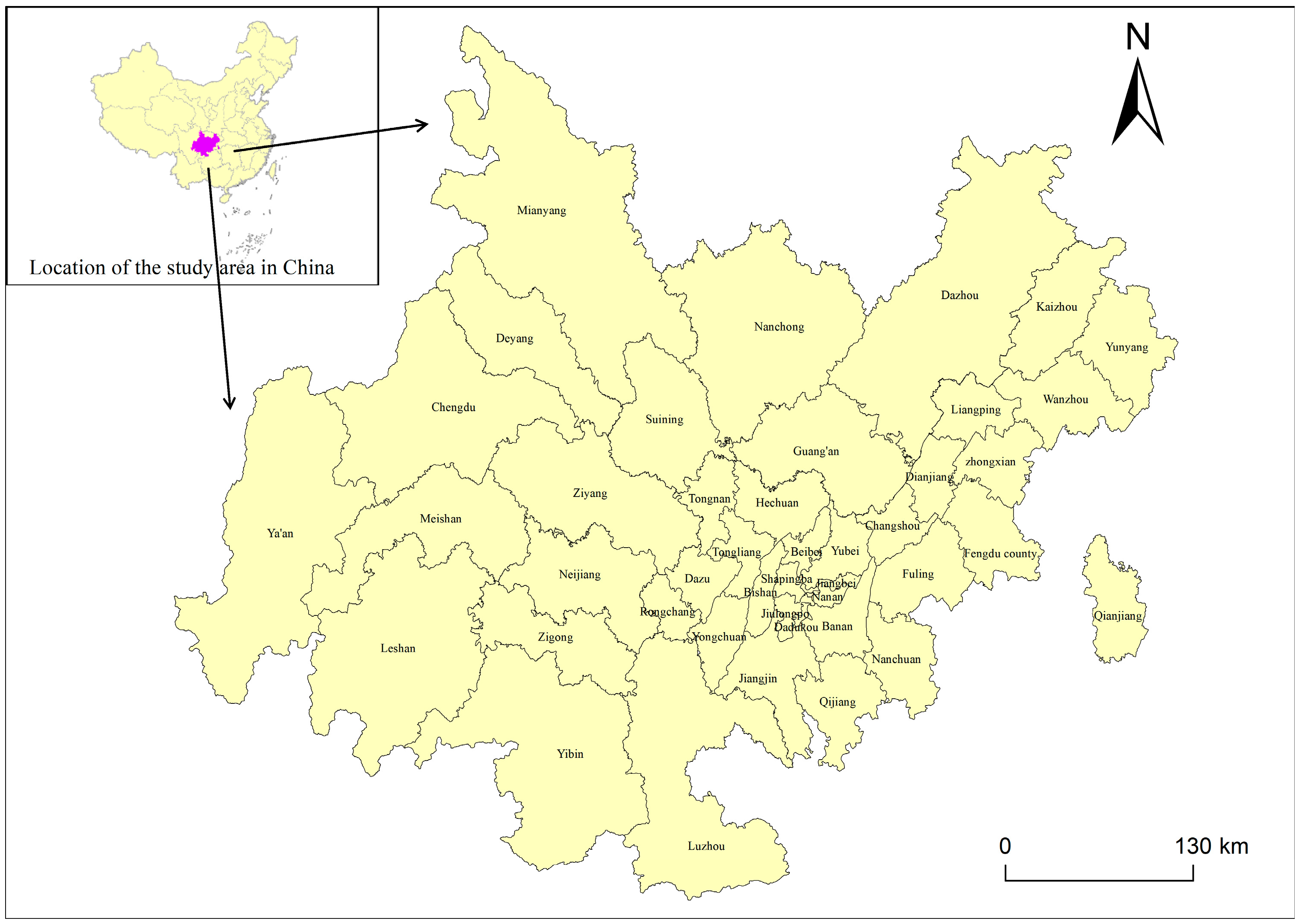
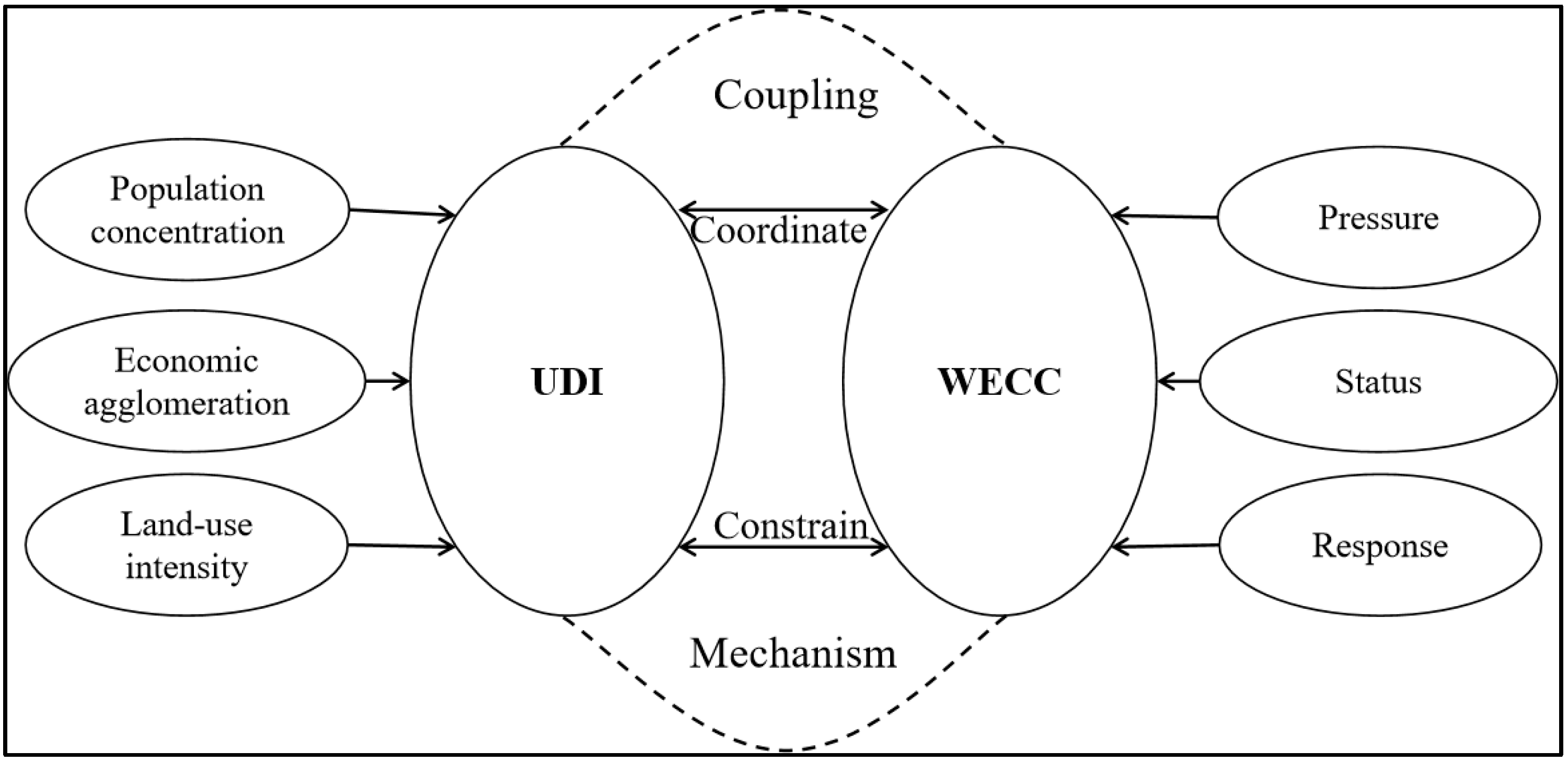
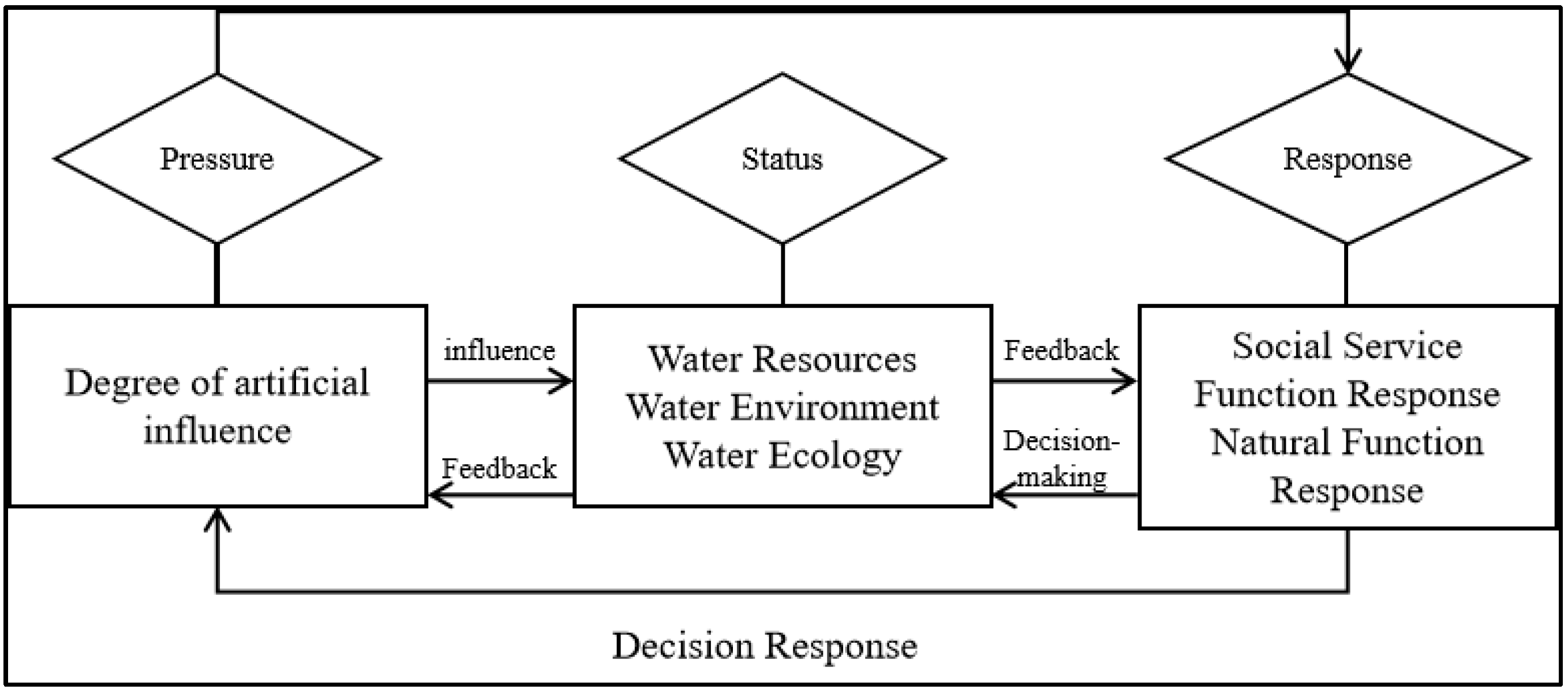
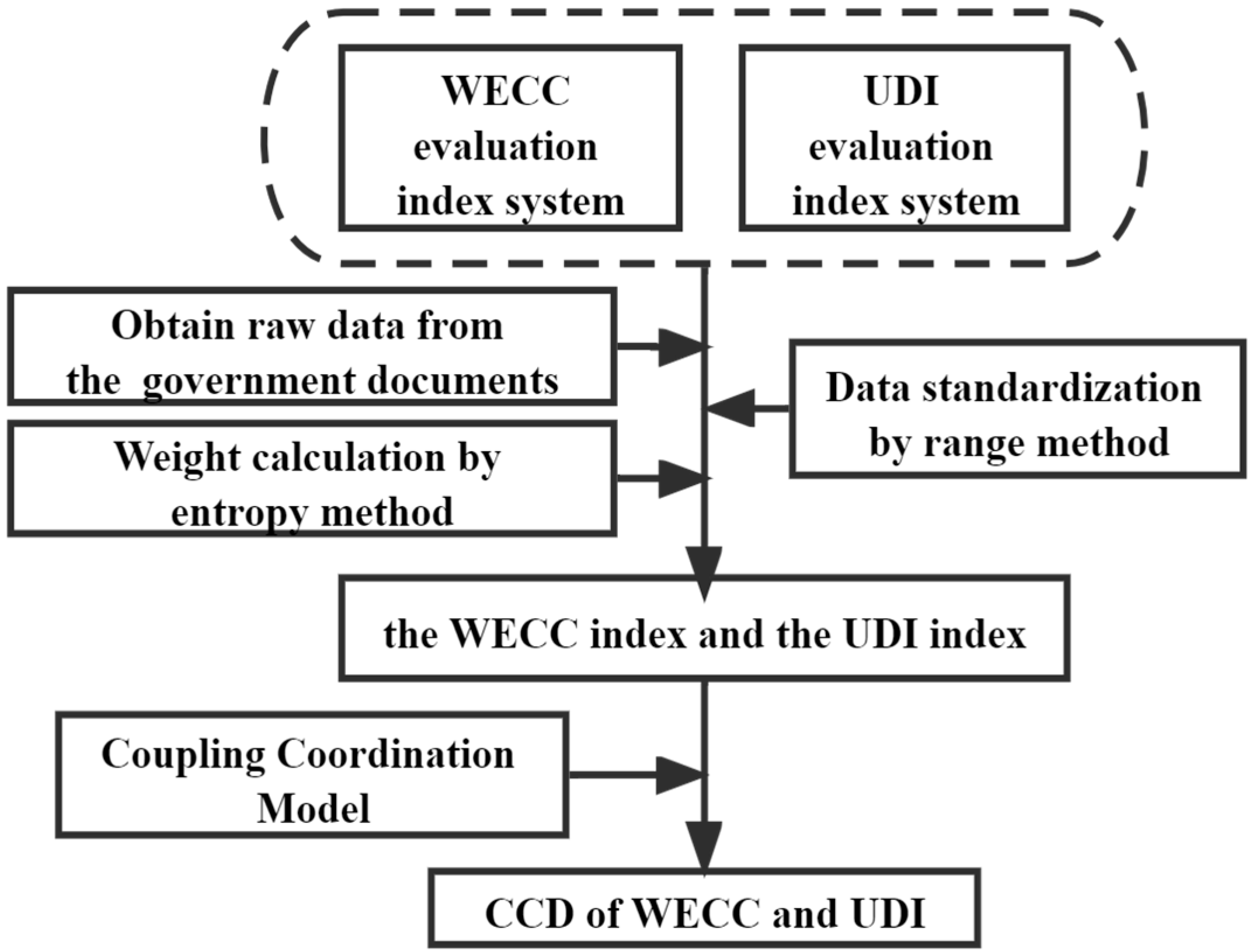
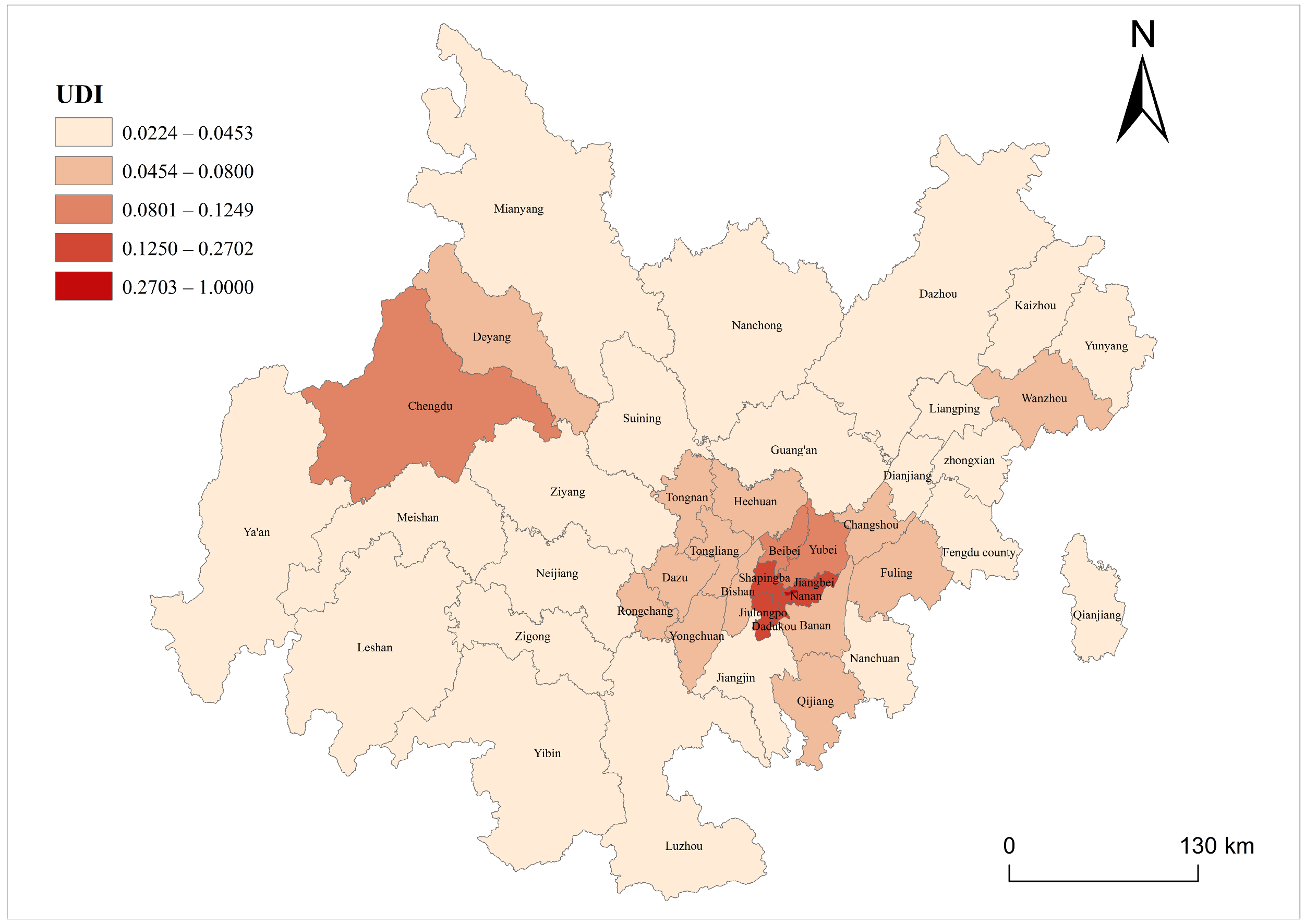
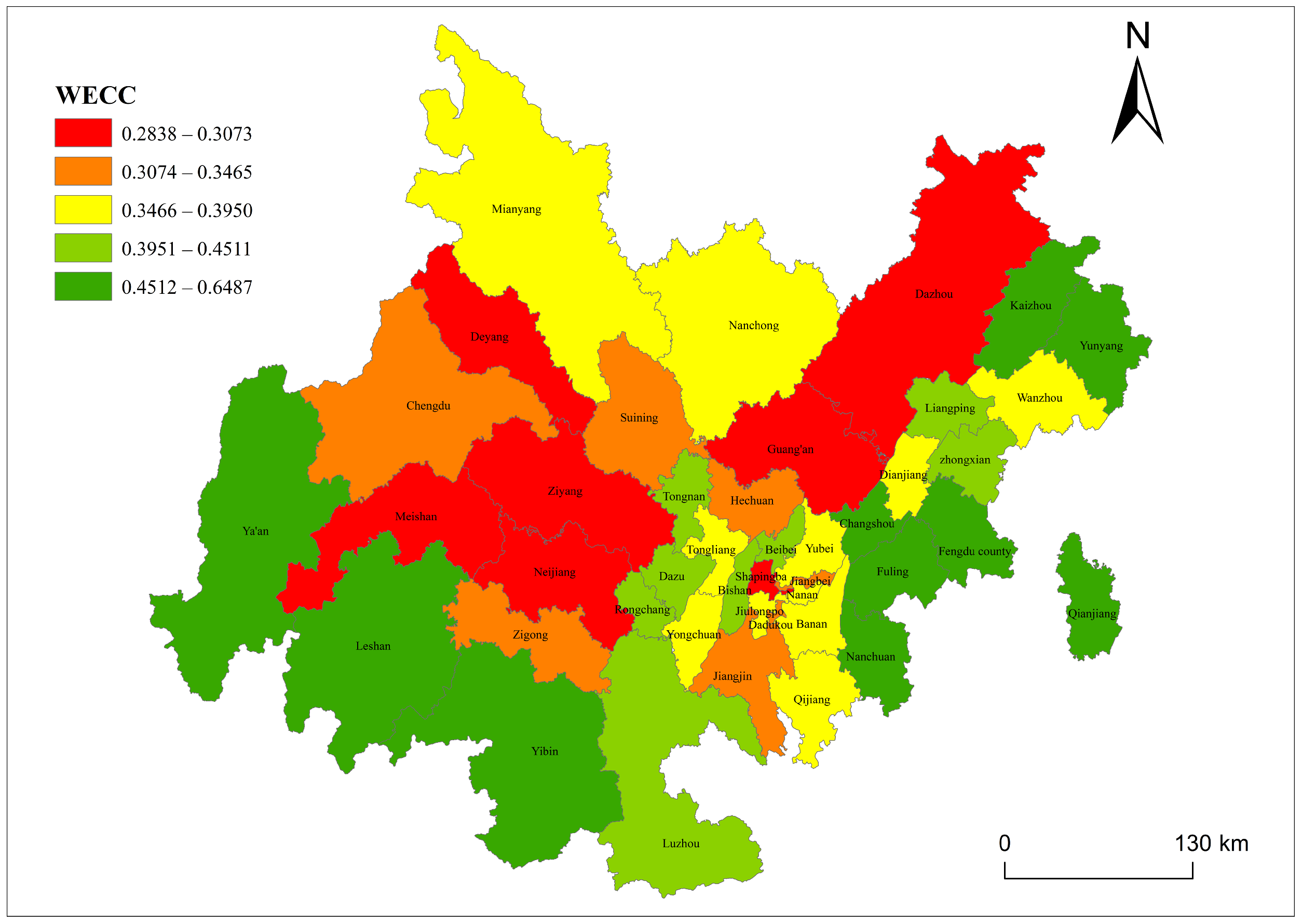
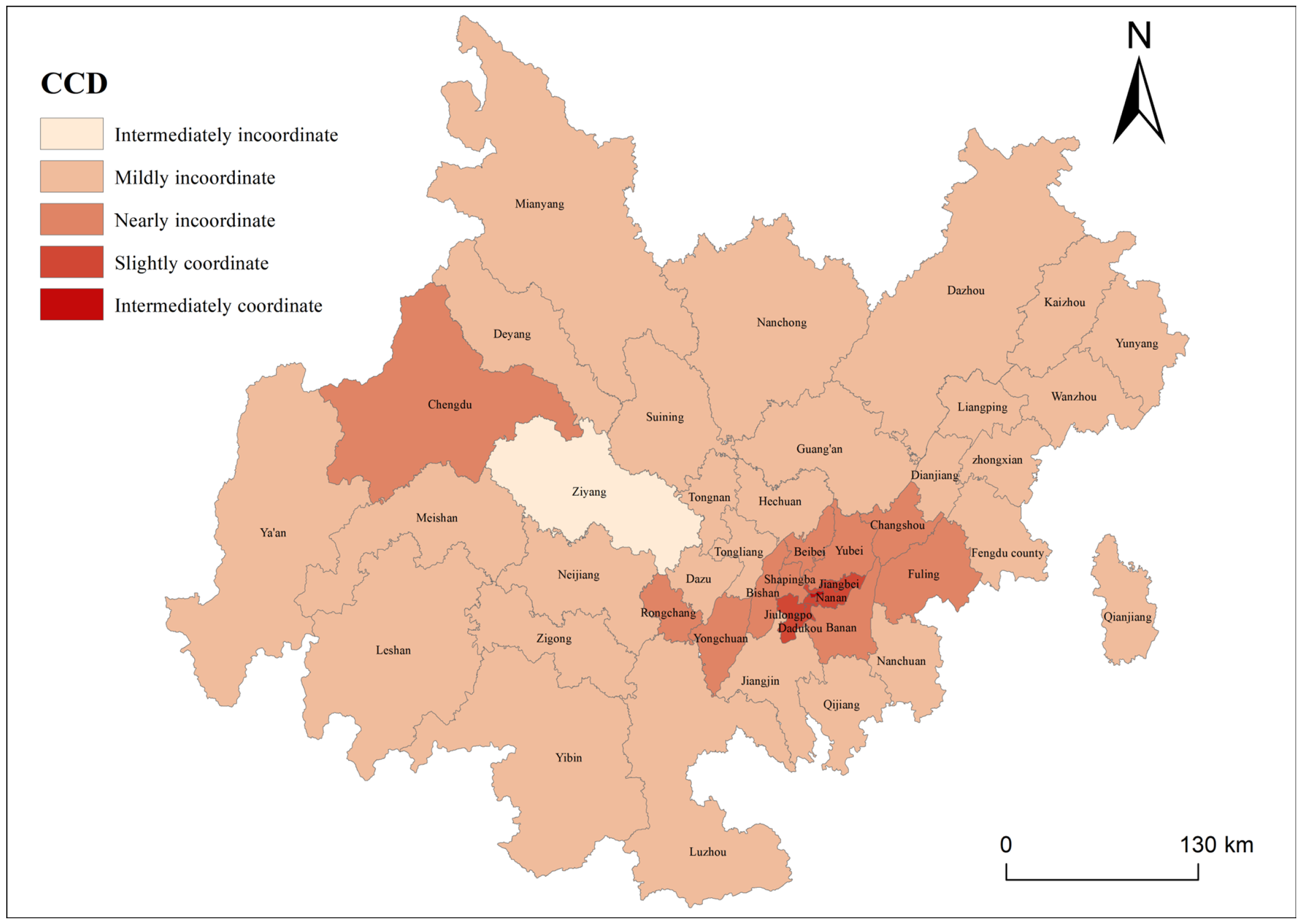
| Target Layer | Guideline Layer | Index Layer | Definition of Index | Unit | Index Type |
|---|---|---|---|---|---|
| UDI (A) | Population concentration intensity (A1) | Population density (A11) | Average number of people per unit area of land | person/km2 | + |
| Urbanization rate (A12) | The proportion of urban residents to the total resident population in a country or region | % | + | ||
| Economic agglomeration intensity (A2) | Economic density (A21) | Ratio of gross domestic product (GDP) to area of administrative | 105 yuan/km2 | + | |
| GDP per capita (A22) | The ratio of GDP to the resident population of a region within the accounting period (usually one year) | yuan | + | ||
| Land-use intensity (A3) | Per capita construction land area (A31) | Total urban building land area per capita allocated to the total urban population | m2/person | + | |
| Percentage of urban built-up area in total area (A32) | Ratio of urban built-up area to total administrative area | % | + |
| Target Layer | Guideline Layer | Index Layer | Definition of Index | Unit | Index Type |
|---|---|---|---|---|---|
| WECC (B) | P (B1) | Water consumption per unit of GDP (B11) | Amount of water consumed per 10,000 yuan of GDP | ton/105 yuan | − |
| Industrial wastewater emissions per 10,000 Yuan GDP (B12) | Industrial wastewater emissions per 10,000 yuan of GDP | ton/105 yuan | − | ||
| Energy consumption per unit of GDP (B13) | Energy consumed by a country or region (to generate) one unit of measure (usually million) of GDP | ton of standard coal equivalent/105 yuan | − | ||
| Daily domestic water consumption per capita (B14) | Average daily domestic water consumption per water user population | L | − | ||
| Industrial COD emissions per unit of GDP (B15) | Industrial COD emissions per 10,000 yuan of GDP | ton/105 yuan | − | ||
| Industrial NH3-N emissionsper unit of GDP (B16) | Industrial ammonia nitrogen emissions per 10,000 yuan GDP | ton/105 yuan | − | ||
| S (B2) | Average annual precipitation (B21) | Average annual rainfall measured at multiple observation points at a site | mm | + | |
| Water holdings per capita (B22) | Average amount of water per person by population | m3 | + | ||
| Water quality compliance rate in water function zones (B23) | Proportion of water functional areas meeting water quality standards to water functional areas evaluated | % | + | ||
| Green space per capita (B34) | Average area of public green space per inhabitant in the city | m2/person | + | ||
| R (B3) | Sewage treatment rate (B31) | Volume of treated domestic and industrial effluent as a proportion of total effluent discharge | % | + | |
| Greenery coverage in built-up areas (B32) | Ratio of greenery coverage to total land area in built-up urban areas | % | + | ||
| Fiscal expenditure on environmental pollution control as a proportion of GDP (B33) | The proportion of financial expenditure on environmental pollution prevention, ecological protection and construction to the local GDP of the year | % | + |
| CCD | Level | CCD | Level |
|---|---|---|---|
| (0, 0.1) | Extremely incoordinate | [0.5, 0.6) | Slightly coordinate |
| [0.1, 0.2) | Seriously incoordinate | [0.6, 0.7) | Basically coordinate |
| [0.2, 0.3) | Intermediately Incoordinate | [0.7, 0.8) | Intermediately coordinate |
| [0.3, 0.4) | Mildly incoordinate | [0.8, 0.9) | Well coordinate |
| [0.4, 0.5) | Nearly incoordinate | [0.9, 1] | Excellently coordinate |
| Target Layer | Guideline Layer | Index Layer | Weights |
|---|---|---|---|
| A | A1 | A11 | 0.2522 |
| A12 | 0.0492 | ||
| A2 | A21 | 0.4201 | |
| A22 | 0.0542 | ||
| A3 | A31 | 0.0218 | |
| A32 | 0.2025 | ||
| B | B1 | B11 | 0.0686 |
| B12 | 0.0174 | ||
| B13 | 0.0257 | ||
| B14 | 0.0311 | ||
| B15 | 0.0982 | ||
| B16 | 0.296 | ||
| B2 | B21 | 0.0379 | |
| B22 | 0.0329 | ||
| B23 | 0.0419 | ||
| B24 | 0.0305 | ||
| B3 | B31 | 0.0644 | |
| B32 | 0.1536 | ||
| B33 | 0.1018 |
| Number | Administrative District | UDI | Number | Administrative District | UDI | Number | Administrative District | UDI | Number | Administrative District | UDI |
|---|---|---|---|---|---|---|---|---|---|---|---|
| 1 | Yuzhong | 1.0000 | 12 | Yongchuan | 0.0719 | 23 | Suining | 0.0453 | 34 | Dazhou | 0.0339 |
| 2 | Jiangbei | 0.2703 | 13 | Fuling | 0.0691 | 24 | Jiangjin | 0.0443 | 35 | Qianjiang | 0.0338 |
| 3 | Dadukou | 0.2252 | 14 | Changshou | 0.0640 | 25 | Zigong | 0.0430 | 36 | Yunyang | 0.0336 |
| 4 | Nanan | 0.2151 | 15 | Rongchang | 0.0634 | 26 | Nanchuan | 0.0409 | 37 | Ya’an | 0.0326 |
| 5 | Shapingba | 0.1952 | 16 | Qijiang | 0.0610 | 27 | Leshan | 0.0401 | 38 | Liangping | 0.0321 |
| 6 | Jiulongpo | 0.1898 | 17 | Tongliang | 0.0606 | 28 | Dianjiang | 0.0381 | 39 | Luzhou | 0.0313 |
| 7 | Yubei | 0.1250 | 18 | Hechuan | 0.0590 | 29 | Yibin | 0.0380 | 40 | Guang’an | 0.0303 |
| 8 | Chengdu | 0.1025 | 19 | Dazu | 0.0555 | 30 | Neijiang | 0.0378 | 41 | Kaizhou | 0.0264 |
| 9 | Beibei | 0.1004 | 20 | Wanzhou | 0.0530 | 31 | Meishan | 0.0366 | 42 | Fengdu | 0.0259 |
| 10 | Bishan | 0.0800 | 21 | Deyang | 0.0515 | 32 | Mianyang | 0.0353 | 43 | Ziyang | 0.0229 |
| 11 | Banan | 0.0777 | 22 | Yongchuan | 0.0493 | 33 | Nanchong | 0.0340 | 44 | Zhongxian | 0.0224 |
| Number | Administrative District | WECC | Number | Administrative District | WECC | Number | Administrative District | WECC | Number | Administrative District | WECC |
|---|---|---|---|---|---|---|---|---|---|---|---|
| 1 | Qian jiang | 0.6487 | 12 | Bishan | 0.4446 | 23 | Nanan | 0.3810 | 34 | Suining | 0.3245 |
| 2 | Ya’an | 0.6180 | 13 | Liangping | 0.4436 | 24 | Tongliang | 0.3696 | 35 | Zigong | 0.3193 |
| 3 | Yun yang | 0.5060 | 14 | Rongchang | 0.4282 | 25 | Dianjiang | 0.3645 | 36 | Jiangjin | 0.3155 |
| 4 | Changshou | 0.4944 | 15 | Luzhou | 0.4078 | 26 | Wanzhou | 0.3644 | 37 | Dazhou | 0.3074 |
| 5 | Yibin | 0.4871 | 16 | Dazu | 0.4070 | 27 | Banan | 0.3641 | 38 | Yuzhong | 0.3073 |
| 6 | Leshan | 0.4869 | 17 | Beibei | 0.4049 | 28 | Mianyang | 0.3582 | 39 | Shapingba | 0.3068 |
| 7 | Fengdu | 0.4835 | 18 | Tongnan | 0.4011 | 29 | Jiulongpo | 0.3561 | 40 | Deyang | 0.3042 |
| 8 | Fuling | 0.4833 | 19 | Qijiang | 0.3951 | 30 | Hechuan | 0.3466 | 41 | Neijiang | 0.2890 |
| 9 | Nanchuan | 0.4768 | 20 | Yongchuan | 0.3876 | 31 | Chengdu | 0.3422 | 42 | Guang’an | 0.2889 |
| 10 | Kaizhou | 0.4760 | 21 | Nanchong | 0.3830 | 32 | Jiangbei | 0.3366 | 43 | Ziyang | 0.2862 |
| 11 | Zhongxian | 0.4512 | 22 | Yubei | 0.3816 | 33 | Dadukou | 0.3289 | 44 | Meishan | 0.2838 |
| Number | Administrative District | CDD | Level | Number | Administrative District | CDD | Level | Number | Administrative District | CDD | Level |
|---|---|---|---|---|---|---|---|---|---|---|---|
| 1 | Yuzhong | 0.7445 | Intermediately coordinate | 16 | Qijiang | 0.3940 | Mildly incoordinate | 31 | Jiangjin | 0.3438 | Mildly incoordinate |
| 2 | Jiangbei | 0.5492 | Slightly coordinate | 17 | Dazu | 0.3877 | Mildly incoordinate | 32 | Dianjiang | 0.3434 | Mildly incoordinate |
| 3 | Nanan | 0.5350 | Slightly coordinate | 18 | Tongliang | 0.3868 | Mildly incoordinate | 33 | Zigong | 0.3423 | Mildly incoordinate |
| 4 | Dadukou | 0.5217 | Slightly coordinate | 19 | Qianjiang | 0.3846 | Mildly incoordinate | 34 | Nanchong | 0.3378 | Mildly incoordinate |
| 5 | Jiulongpo | 0.5098 | Slightly coordinate | 20 | Hechuan | 0.3781 | Mildly incoordinate | 35 | Luzhou | 0.3362 | Mildly incoordinate |
| 6 | Shapingba | 0.4947 | Nearly incoordinate | 21 | Ya’an | 0.3766 | Mildly incoordinate | 36 | Mianyang | 0.3354 | Mildly incoordinate |
| 7 | Yubei | 0.4673 | Nearly incoordinate | 22 | Tongnan | 0.3750 | Mildly incoordinate | 37 | Kaizhou | 0.3347 | Mildly incoordinate |
| 8 | Beibei | 0.4490 | Nearly incoordinate | 23 | Leshan | 0.3738 | Mildly incoordinate | 38 | Fengdu | 0.3344 | Mildly incoordinate |
| 9 | Bishan | 0.4343 | Nearly incoordinate | 24 | Nanchuan | 0.3737 | Mildly incoordinate | 39 | Neijiang | 0.3232 | Mildly incoordinate |
| 10 | Chengdu | 0.4327 | Nearly incoordinate | 25 | Wanzhou | 0.3727 | Mildly incoordinate | 40 | Dazhou | 0.3195 | Mildly incoordinate |
| 11 | Fuling | 0.4275 | Nearly incoordinate | 26 | Yibin | 0.3687 | Mildly incoordinate | 41 | Meishan | 0.3192 | Mildly incoordinate |
| 12 | Changshou | 0.4217 | Nearly incoordinate | 27 | Yunyang | 0.3611 | Mildly incoordinate | 42 | Zhongxian | 0.3171 | Mildly incoordinate |
| 13 | Banan | 0.4101 | Nearly incoordinate | 28 | Deyang | 0.3537 | Mildly incoordinate | 43 | Guang’an | 0.3059 | Mildly incoordinate |
| 14 | Yongchuan | 0.4086 | Nearly incoordinate | 29 | Suining | 0.3482 | Mildly incoordinate | 44 | Ziyang | 0.2846 | Intermediately incoordinate |
| 15 | Rongchang | 0.4060 | Nearly incoordinate | 30 | Liangping | 0.3456 | Mildly incoordinate |
Disclaimer/Publisher’s Note: The statements, opinions and data contained in all publications are solely those of the individual author(s) and contributor(s) and not of MDPI and/or the editor(s). MDPI and/or the editor(s) disclaim responsibility for any injury to people or property resulting from any ideas, methods, instructions or products referred to in the content. |
© 2023 by the authors. Licensee MDPI, Basel, Switzerland. This article is an open access article distributed under the terms and conditions of the Creative Commons Attribution (CC BY) license (https://creativecommons.org/licenses/by/4.0/).
Share and Cite
Deng, H.; Yang, J.; Wang, P. Study on Coupling Coordination Relationship between Urban Development Intensity and Water Environment Carrying Capacity of Chengdu–Chongqing Economic Circle. Sustainability 2023, 15, 7111. https://doi.org/10.3390/su15097111
Deng H, Yang J, Wang P. Study on Coupling Coordination Relationship between Urban Development Intensity and Water Environment Carrying Capacity of Chengdu–Chongqing Economic Circle. Sustainability. 2023; 15(9):7111. https://doi.org/10.3390/su15097111
Chicago/Turabian StyleDeng, Hongwei, Jinxin Yang, and Peng Wang. 2023. "Study on Coupling Coordination Relationship between Urban Development Intensity and Water Environment Carrying Capacity of Chengdu–Chongqing Economic Circle" Sustainability 15, no. 9: 7111. https://doi.org/10.3390/su15097111
APA StyleDeng, H., Yang, J., & Wang, P. (2023). Study on Coupling Coordination Relationship between Urban Development Intensity and Water Environment Carrying Capacity of Chengdu–Chongqing Economic Circle. Sustainability, 15(9), 7111. https://doi.org/10.3390/su15097111







